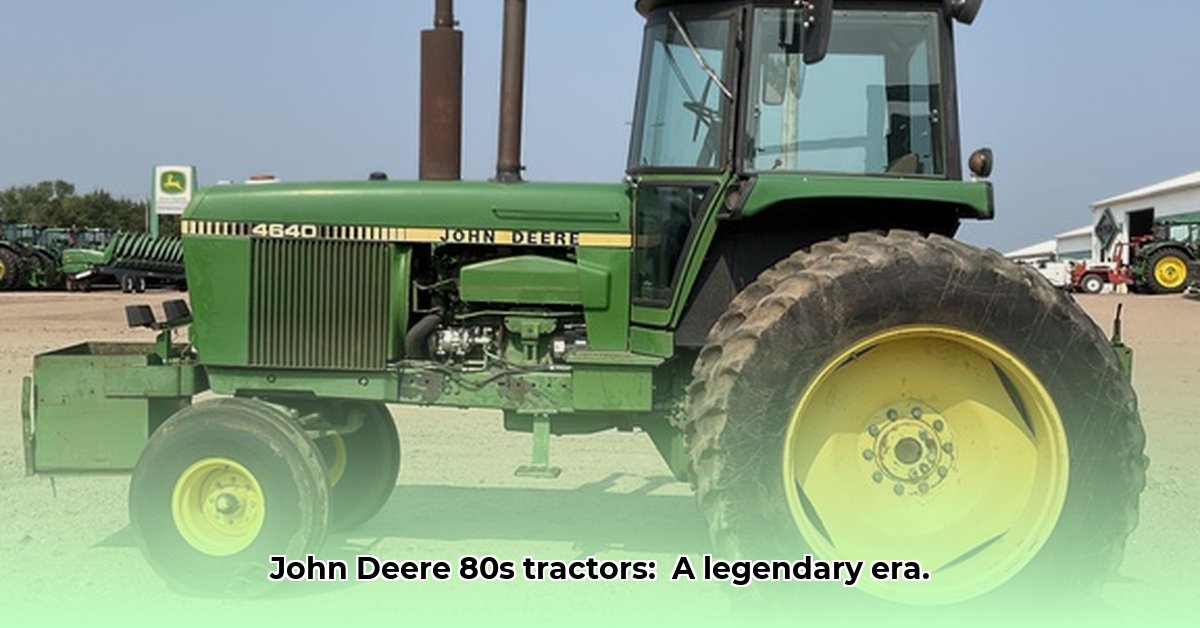
The 1980s marked a pivotal era for John Deere tractors, ushering in a technological revolution that redefined agricultural machinery. These weren't simply incremental improvements; they represented a significant leap forward in power, efficiency, and operator comfort, impacting farming practices and environmental considerations for decades to come. For more details on these innovations, see this page on 1980s Deere tractors. This article explores the key innovations of John Deere's 1980s tractors, their impact on sustainable agriculture, and their enduring legacy.
Technological Advancements in 1980s John Deere Tractors
Several groundbreaking technologies propelled John Deere tractors to the forefront of agricultural innovation during the 1980s. One of the most transformative was the widespread adoption of mechanical front-wheel drive (MFWD). Prior to MFWD, traction was a significant limitation, particularly in challenging field conditions. This often resulted in wasted fuel and reduced productivity. MFWD dramatically improved traction, leading to better fuel efficiency and increased output. Wasn't this a significant leap forward in optimizing both performance and resource management?
Diesel engine technology also experienced a major leap forward. John Deere engineers dramatically improved fuel efficiency, reducing the amount of fuel needed to complete the same amount of work. This translated to significant cost savings for farmers and minimized the environmental impact of farming operations. Consider the substantial difference in operating costs between a 1970s model and its 1980s counterpart—a difference likely to have been substantial.
Key Model Improvements and Features
While a comprehensive overview of all models is beyond the scope of this article, several notable advancements characterize the 1980s John Deere tractors. Many models incorporated significantly improved hydraulic systems, enhancing the versatility and precision of attached implements. Farmers benefited from enhanced control and accuracy, optimizing tasks like plowing and planting. The improvement in responsiveness was akin to the difference between driving a modern car and a much older one – a significant and recognizable upgrade for the operator.
Furthermore, John Deere prioritized operator comfort, recognizing its direct impact on productivity. Enhanced seating, more intuitive control layouts, and improved visibility contributed to greater operator efficiency and reduced fatigue. These ergonomic improvements may appear minor, but their cumulative effect on the overall efficiency of farm operations was substantial.
The Environmental Impact: Sustainability Takes Center Stage
The innovations of the 1980s weren't solely focused on improved efficiency and profitability; they also played a vital role in advancing sustainable agriculture. The enhanced fuel efficiency of these tractors directly resulted in lower emissions, lessening the environmental footprint of farming practices. This was particularly significant at a time when growing environmental awareness was driving a demand for more responsible agricultural practices.
Moreover, the increased efficiency meant that farmers could potentially cultivate more land using fewer resources. This reduced the pressure to expand farmland into ecologically sensitive areas, helping in the preservation of vital habitats. The design advancements of the 80s represented a clear movement toward sustainable practices that resonate strongly with modern farmers.
The Enduring Legacy: A Pivotal Moment in Agricultural History
John Deere's 1980s tractors weren't merely machines; they represented a watershed moment in agricultural history. Their impact extended far beyond increased efficiency and profitability. They demonstrated a commitment to precision, sustainability, and operator well-being – values that underpin modern agricultural practices. Their legacy continues to shape the design and functionality of contemporary agricultural equipment, inspiring innovation and influencing farming practices worldwide.
Areas for Further Research
To gain a deeper understanding of the impact of these tractors, further research is crucial. This includes detailed studies of fuel consumption across various models and operating conditions, a comprehensive analysis of emission levels, and a complete life cycle assessment of these machines, considering their environmental impact from manufacturing to disposal. Examining maintenance records, operator feedback, and production data would provide further insights into their contribution to increased farm productivity and sustainable agriculture. What specific aspects of this technological evolution would you find most interesting to explore further?
How Did John Deere Tractor Emissions Evolve From 1918 To 1989?
The evolution of John Deere tractor emissions from 1918 to 1989 reflects a significant shift in engineering priorities, driven by increasing environmental awareness and tighter regulations. Early tractors, while marvels of engineering for their time, largely disregarded emissions. The focus was solely on power and durability. However, by the 1980s, environmental concerns spurred the development of technologies to mitigate the environmental impact of agricultural machinery.
The 1980s witnessed the integration of several emission-reduction technologies into John Deere tractors. These included improved engine design to optimize combustion efficiency, exhaust gas recirculation (EGR) systems to reduce NOx emissions, and advancements in fuel injection systems for more precise fuel delivery. While these solutions were less sophisticated than contemporary systems, they marked a critical step toward cleaner agricultural machinery. The legacy of these early emission control measures laid the foundation for the cutting-edge technologies used in modern tractors.